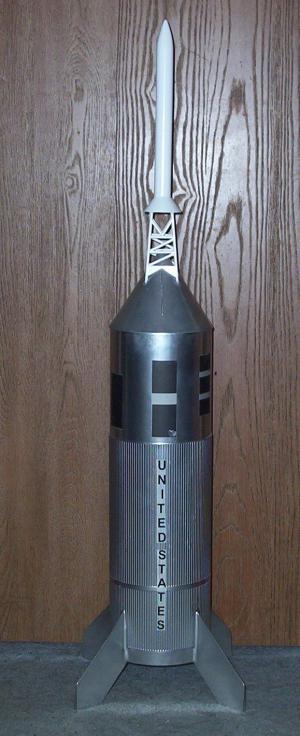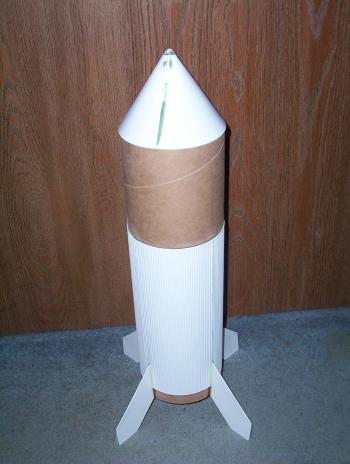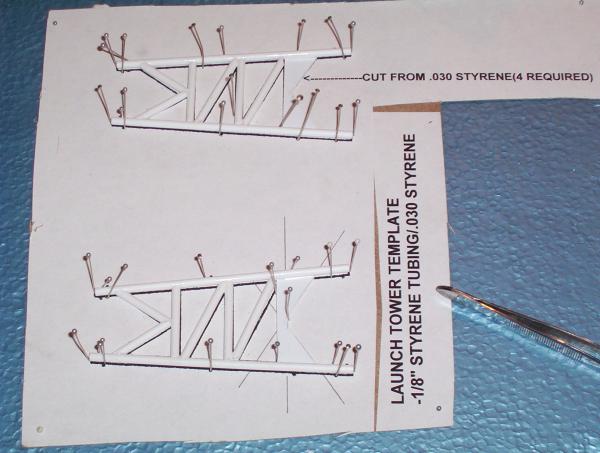| Construction Rating: | starstarstarstarstar_border |
| Flight Rating: | starstarstarstarstar |
| Overall Rating: | starstarstarstarstar_border |
| Manufacturer: | Sheri's Hot Rockets  |
 Brief:
Brief:
Sheri's Hot Rockets Little Joe II is a mid power (29mm engine mount), 1/30 scale model of the popular NASA test vehicle that was used during the mid 1960s to test the Apollo Launch Escape System. Sheri keeps a consistent "Buy It Now" presence on eBay or you can order it direct off her website. As of this writing, the list price is $89, although she does have occasional sales where she'll knock the price down a bit and/or offer free shipping.
It should be noted that Sheri's Hot Rockets is a small operation and often her kits are literally made to order, so there may be a significant lag between placing your order and shipment. On the plus side, I've exchanged a number of emails with Sheri, and she will give reasonably accurate estimates of shipping dates and her replies were generally timely--often within a couple hours.
Construction:
The kit includes the following:
- 1 main body tube, 5.25" x 24"
- 1 29mm engine mount tube
- 1 Styrene sheet 0.010" thick
- 1 Styrene sheet 0.030" thick
- 2 sheets corrugated styrene wraps
- 3 centering rings, 1/8" thick
- 5 pieces 1mm x 1mm square styrene detail strips
- 5 pieces 1/8" round styrene tubing
- 1 hardwood dowel 7/8" round x 9 3/4"
- 1 hardwood dowel 1/2" round x 1"
- 2 square fiberboard blocks 1/8" x 1" x 1"
- Shock Cord eyelet with blind nut
- Shock Cord eyelet with screw end
- 2 launch lugs 1/4"
- 1 sheet waterside decals
- 1 sheet vinyl decals
- Full size construction drawing
- Instruction Manual
- Template Manual
Sheri's kits do not include parachutes or shock cords. She recommends a 55"-60" chute.
 The instructions are 24 pages with plenty of photos and tips, plus the nice full size drawing of the complete rocket. Although the instructions are pretty good, it is very helpful to be able to refer to the full size drawing to make sure. Sheri's rocket kits could be considered old school, where you actually have to build the rocket, not just assemble some parts.
The instructions are 24 pages with plenty of photos and tips, plus the nice full size drawing of the complete rocket. Although the instructions are pretty good, it is very helpful to be able to refer to the full size drawing to make sure. Sheri's rocket kits could be considered old school, where you actually have to build the rocket, not just assemble some parts.
The kit is somewhat defined by the body tube. It is big, heavy (0.125" wall thickness), unfinished (no coating, which makes finishing a challenge), and not cut to length. In fact, not only do you need to cut the main body tube to length, you also need to make the coupler for the base of the Apollo capsule. Also, the thickness of the body tube makes cutting it potentially tricky. I used a razor saw, which cut the thick tubing easy enough, but making the cut perfectly straight was not trivial.
The fins are built up construction, using the 0.030" thick styrene sheet. This worked better than I expected. Getting the fins straight and symmetric wasn't difficult, and the resultant fins were reasonably strong (although I did go ahead and fill the fins with spray in foam for a little extra strength).
The use of the corrugated styrene sheets as wraps to simulate the main body stringers works out well, and the use of the 1mm square strips for detail are a nice touch. The net effect has a much better scale appearance then is possible with embossed or vacu-formed wraps. The only tricky part of the corrugated wraps is getting good vertical seams (there are two vertical seams, since the sheets are not long enough for one wrap to reach completely around the large body tube).
The capsule and escape tower are almost literally made from scratch. For the capsule, a cone is made from the 0.030" styrene sheet with a hardwood piece for the very tip. The base is one of the (provided) centering rings, and the coupler is made out of a piece cut from the main body tube. Of course, the real fun is building the escape tower out of the 1/8" styrene tubing and some 0.010" styrene sheet. The launch escape motor is made from the 7/8" hardwood dowel, which you need to carve/sand to a point on one end. The shroud at the bottom of the escape motor is made up of more 0.030" styrene sheet. The instructions and templates provided are good and the end result came out nice but be prepared for a time consuming build.

Finishing:
I deviated slightly from the assembly instructions to make painting easier. The Little Joe II QTV is a mono color chrome finish, except for the launch escape system. So rather than try and mask around the escape tower legs, I painted the launch escape system separately and then attached it to the capsule after everything was painted.
Applying a finish to the rocket was tricky, mainly due to the raw surface of the body tube. Although only about 1/3 of the body tube surface is exposed (with the remainder being covered by the corrugated wraps), it took numerous coats of primer and lots of sanding to get a decent surface for the color coat. (Don't even think of wet-sanding the primer. Any moisture getting under the primer to the body tube will cause it to swell which will give you even more problems.)
Note: Since finishing the LJ II, I've built Sheri's Saturn 1B. After looking at the large body tube areas, I tried something different that worked well. Before assembly, I took Elmer's Fill 'n' Finish (very slightly thinned) and used my fingers to rub it into all the exposed body tube surfaces, then sanded it down with 180 grit sandpaper after it had dried. The resultant body tube surface was much easier to finish, not much different than conventional coated body tubes.
When I was finally satisfied with the surface finish, I applied the color coat. For the booster, Sheri recommends Testor's Chrome spray paint, but I chose to us Krylon Chrome spray (cheaper and more readily available and I think it looks just as good). I used Krylon gloss white paint on the launch escape system. Once everything was dry, I added the waterslide decals and vinyl roll patterns. The waterslide decals were OK, but I have a gripe with the vinyl roll patterns. The vinyl gives a matte finish, which looks out of place on the otherwise glossy chrome finish. Oh, and a potential gotcha: the roll patterns are not a wrap. You need to cut them out and apply them individually. Overall, I give it a 4, downgrading a bit due to the difficulty in finishing the rough body tube.
Construction Rating: 4 out of 5
Flight and Recovery:
To prepare for flight, I added a 60" nylon parachute and a 10' shock cord of nylon strap.
Its first flight was during the sport launch portion of NARAM 50, where it attracted a great deal of interest. It seemed like everyone either wanted confirmation it was Sheri's kit or wanted to know what it was and if it was available as a kit. The finished rocket is heavy, 2.5 pounds without an engine, so I chose a G64-4W RMS for the maiden flight. Boost was beautiful and straight as an arrow. Ejection occurred right after apogee, and then trouble--the parachute became tangled and didn't open. Fortunately the tangled chute slowed the descent somewhat with the rocket managed to land on its side. Damage was moderate. One fin was destroyed, another was damaged, and the escape tower snapped off at the base. All were fixable, but it's planned second NARAM flight was not to be. Flight rating is a 5 despite the landing--the fouled parachute wasn't Sheri's fault.
A couple notes on the repairs: One fin was pretty well destroyed, so I decided to simply make a new fin. (There was plenty of 0.030" styrene leftover from the original build.) However, on the second fin, I attempted to do a repair instead of replacing it with a new fin. In hindsight, I spent at least as much time on the repaired fin as I did the replaced fin, yet the repaired fin still doesn't look quite right. I should have simply replaced both damaged fins. It would have been tricky to spot repair the chrome paint, so I elected to repaint the entire booster portion - which meant I'd need new decals. I emailed Sheri and she provided replacement decals no problem, so the repaired model is nearly good as new.
Flight Rating: 5 out of 5
Summary:
I'm very happy with Sheri's Little Joe II kit, enough that I've purchased several of her other kits, and I give it an overall rating of a 4.5. As noted, I've already built the Saturn 1B, and the Saturn V will be next. Be prepared: these kits are tough builds. I'd rate the Little Joe II as a Skill Level 4 or 5 (and the Saturn 1B a 5 or maybe even higher). In some ways, these kits are throw backs to the early days of rocketry, the days before pre-cut fins and pre-assembled parachutes.
Overall Rating: 4 out of 5
Other Reviews
- Sheri's Hot Rockets Little Joe II By Robert Koenn (November 9, 2008)
I think the Apollo Little Joe 2 is probably my favorite rocket of all time. I am not sure why but I liked the appearance of it back in the late '60s when I purchased my first Estes kit during my high school days. I think it is the Apollo capsule and launch escape system (LES) parked on top of a stubby, brute force rocket of very basic design. The actual vehicle was a conglomeration of solid ...
- Sheri's Hot Rockets Little Joe II By Andrew Connors (August 10, 2007)
This kit is From Sheri's Hot Rockets, part of CJS aviation. This Little Joe II kit is a 29mm MPR/HPR 1/30th scale kit of the famous LJ2 QTV. It's a single stage 29mm configuration although you could cluster or use a larger MMT if you used thicker centering rings. Single BT made from heavy gauge kraft tubing and all four fins, body wraps, modules and the tower are made from styrene plastic. ...
 |
 |
Roger Smith (September 20, 2011)
Note: Sheri's Hot Rockets products are now manufactured and distributed by Red Arrow Hobbies. Red Arrow Hobbies has a good reputation and we have heard of no problems with orders for Sheri's Hot Rockets products since Red Arrow Hobbies began selling the kits.
Sponsored Ads
 |
 |












K.J. (April 3, 2010)